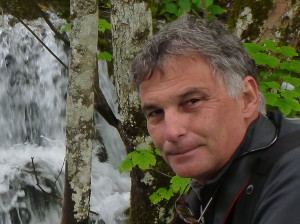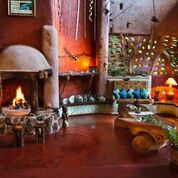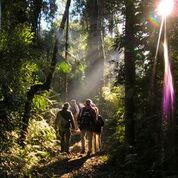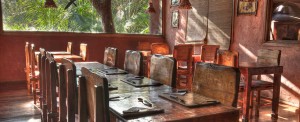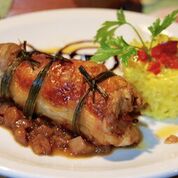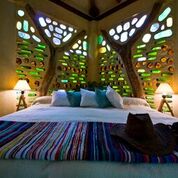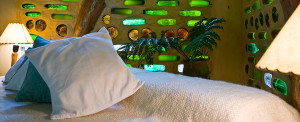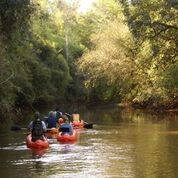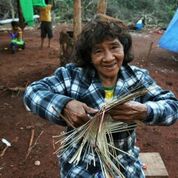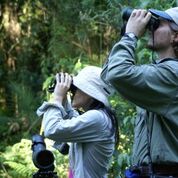Editor’s note: In 2013 my wife and I visited Iguazu Falls, which straddles the border between Argentina and Brazil. According to Wikipedia, these falls are the largest waterfall system in the world. We were both awe struck by the sight as we walked over sections of the falls via narrow bridges that connect small islands hugging the lip of the precipice. Little did we know that at that moment we were just two hours drive from one of the most unique ecolodges in either Argentina or Brazil—the Yacutinga Lodge. I recently had the opportunity to speak with Carlos Sandoval, the founder and owner of the lodge.
Carlos, I see on your website that you came up with the idea of the lodge in 1998, and opened for business in 2000. What was it in your background that gave you the idea that you’d be able to build a successful ecolodge where none existed?
I actually thought about creating Yacutinga Lodge before that, it was the year 1996.
At that time I was working in Paraguay developing a tourism agency that was focused on biological and ecological tourism. It was then that I discovered that there were no jungle lodges whatsoever near the Iguassu Falls area. This caught my attention very sharply because the Iguassu Falls are a must for every South American tourism circuit.
Since I was already immersed in the tourism area, I was strongly convinced to create Yacutinga Lodge. It was always in my mind that lucrative ecotourism should sustain the hosting communities, not only to generate an economic income or even better their infrastructure, but also to help them conserve their natural resources and to perpetuate their cultural heritage.
Most of the tourism that I had back then in Paraguay came from the Iguassu Falls as its natural entrance gate.
My passion for nature, original cultures, and organic architecture were added to my decision to build Yacutinga Lodge. In short, Yacutinga is a result of all of these. Opportunity, foresight, love for nature, originality, and fundamentally the idea about leaving a positive mark in this life helped lead me to this decision.
During the construction process, many ecolodges try to incorporate local, natural materials to minimize both the expense of importing materials, and the impact on the environment. Were you able to do this during the construction of the Yacutinga Lodge?
I didn’t just do it, I felt it was mandatory to do it!!
Since I studied architecture and dedicated so many years to ecotourism, I knew that in order to achieve something good I had to base myself in the local knowledge, local resources, local population, and in their construction systems. I also knew that a jungle lodge must be settled as a business, thus the architecture should reflect not only a strong jungle look, but at the same time, minimize the costs of maintenance to keep it efficient over time.
If we had built the lodge using foreign materials it would have been a great mistake. The fun part about this (and the creative part) is that Yacutinga Lodge counts on recycling systems and natural resource that are very far away from modern technology.
When you read, inform yourself, and investigate, one figures out that since the beginning of settling, the pioneers always took advantage of local natural resources to build houses and shelter. Thus Yacutinga was constructed with the belief that local knowledge would reduce future mistakes. For example, Yacutinga doesn’t use solar panels–it doesn’t need them. To save energy we simply use it in small amounts. To keep the place fresh we planted additional trees that provide shadow and humidity. Nature is super wise … we just need to interpret it correctly.
Another common characteristic of ecolodges is their attempt to minimize the environmental impact during their operation. Is that the case at the Yacutinga Lodge?
Yes, of course. We not only did everything imaginable to minimize the impact during the building process, we also decided that upon completion we would run jungle enrichment programs and biological inventories to have a valid picture of the environmental and how the construction altered it, and proceed to immediately take corrective measures when needed. In other words, we not only worked to minimize any harm to the environment, but also we took responsibility to fix it.
I see on your website it states that the lodge is in the private Yacutinga Wildlife Refuge, that it covers over 570 hectares (1400 acres), and that you’ve planted over 30,000 native trees in the area. Can you talk a bit more about the environment?
As I said in the beginning, I wanted to build the first ecolodge in Argentina and settle it in the Iguassu Falls surroundings. I knew that I could achieve it, I knew that I could introduce it into the touristic market, and I also knew it would work. The only thing I didn’t know was where I would start doing it!
I had the idea, the concept, and the facts on how to proceed, I also had already drawn the first concepts for its future eco-tourism use. What I was missing was the place to do it.
I searched and searched for a couple of years, I knew that the place of settlement should be in private hands because it was not in my interest to do it in public protected areas. I also wanted a place not too close to the Iguassu Falls and its massive development, but not so far away to impact transportation and logistic costs.
Also, the location should guarantee Yacutinga with an important environmental health to allow us to do a delicate and focused environmental handling, and on top of everything else, to better the conditions of the habitat from which we would nourish ecotourism. That’s a fundamental law for this type of business.
Want it or not, tourism generates a negative impact even if you are careful–it is the eternal conflict between conservation and preservation. That is why I preferred a place that permitted me to have the needed managing independence to do the things with my knowledge and convictions. I knew I would do just great!
Because you are back in the jungle, I’m guessing you provide meals to your visitors. Can you describe what sort of food your guests may taste at the lodge?
Being a lodge in Argentina, some people might think all our meals are beef barbecues. This is far from our idea of how to serve our guests. The lodge menu has been developed over the years and altered by listening to the preference and comments of our guests.
The restaurant itself is a place to relax, to meet other guests, and to exchange experiences from the day’s experiences and life in general. As such, our food must respect the ambience created by candlelight and fireplaces. We love to bring this ambience to dinner and lunch. Even breakfast serves as a magic moment while waking up with the first sun and song of birds. Guests get to start the day in concordance with mother Earth.
As a result, our meals are prepared with love, have a good nutrition balance, and are presented with a nod of respect to the indigenous peoples. We mix culinary traditions with plenty of fresh organic vegetables, jungle wild fruits, and wild honey. Sometimes our guests, during their excursions, pick up fruits and seeds from the wild. Our kitchen takes advantage of these visitor harvests, and includes those that are edible.
Eating in the jungle is a unique experience. We like our guest to enjoy their time in Yacutinga, so our kitchen works with our ingredients to bring the jungle into each course. As an example, one of the most successful menu combinations is chipa guazu (native guaraní corn mousse), beef with yerba mate sauce, and toasted wild honey ice cream for dessert.
Now that I know about your background, the building and operation of the lodge, as well as the environment, let’s talk a bit about what the complex has to offer. First, can you describe the physical characteristics of the buildings?
Once I found the place of implantation, I wandered it, lived in it for about a year with some biologists that are friends of mine, and we did the first fauna inventories. We were able to figure out the environmental state of the place with this. Knowing if there were species that were endangered or protected by law, I needed to have a clue of what would surround the lodge and its visitors.
The Interior Atlantic Rainforest is subtropical and truly amazing. We’re talking about one of the most biodiverse environments in the globe. It was obvious that the lodge couldn’t prevail as a building before such amazing natural richness, nor could it impact in a negative way with its touristic activity. These were the concepts I respected when doing the final design, which is characterized by its round shapes, natural colors, recycled materials, simplicity, and surprising design. I would rather say that it is a mix between a rustic style and some flashes from Gaudi and organic architecture.
We like to say that in Yacutinga we don’t focus on giving comfort, but we like to give equilibrium. By living in the jungle we found out how expensive things are, how difficult it is to get them, and obviously to maintain them. Yacutinga Lodge is a place with no front desk, it doesn’t receive credit cards, it has little artificial illumination, no TV nor a big pool with cascades that are stereotypes of a jungle resort. In the contrary, it’s all about nice and simple ideas materialized in place–they are balanced, recycled, and incorporated not only with love towards nature that rules the place but also with the good feelings towards our guests.
Just to give you an example, we have 20 rooms incorporating a stunning jungle style. But not only do they have a view to the jungle, they are in the middle of it!
All of them have a chimney that runs on wood like the old days. This is because the jungle in the months of July and August can be cold and humid. Therefore, what is better than sleeping with the heat of a fireplace while listening to an owl sing? This is something that our ancestors lived but that we, in the middle of the 21st century hectic lifestyle, shamefully can’t.
In Yacutinga Lodge these type of gifts are still present.
Being located in a subtropical jungle and close to Iguazu falls, there must be a lot of activities you offer your guests. Can you describe your typical guests and what they like to do while visiting?
Apart from offering guided walks and kayaking the calm waters of the lodge, we have discovered that the most important things for the guests is something unexpected, the experience of actually living in the jungle. It is about getting dirty with mud when you rescue an orchid and place it in a tree, making homemade bread, asking for a machete from the tourist guide and learning how to get drinkable water from the bark of a liana, enjoying the peace at the fireplace, spotting a new star within the thousands of millions that the Milky Way offer us, identifying birds just by hearing their singing, about comprehending the natural cycles and the timing of nature.
That is what our guests truly enjoy, not just walking and paddling through the jungle.
Beyond the experience of staying in a subtropical rainforest, we believe any visitor to Yacutinga will benefit from additional experiences. Discovering and exploring the trails and waters of the Yacutinga Private Reserve during our organized excursions will definitely feed and broaden one’s knowledge about this type of ecosystem.
The ecosystem surrounding the Yacutinga Lodge is one of the most threatened natural environments of our planet. Because we love this jungle, we helped set aside 570 hectares of jungle that compose the Yacutinga Private Reserve. The atmosphere dominating this place is of respect to the environment, and we want our guest to get to know its environmental situation and state of conservation. Our guests are not just visitors, but also have the ability to directly or indirectly help us maintain this environmental relic. Any guest, while deciding to participate in what we’re doing here, will make their holiday not only interesting, but also socially and environmentally useful.
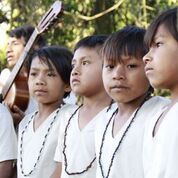 Two of the more popular tours we offer are the “Yacutinga Experience”, which is a package of two nights at the lodge with canoeing and soft jungle hikes guided by ecologist, and the “Yacutinga Origins”, which includes three nights at the lodge. The Origins tour parallels the same itinerary as the Yacutinga Experience, but adds a third day and night to include a social visit to the neighbour native Guarani Community. In short, the Yacutinga Experience is the best extension to learn about this environment after the traditional visit to the Iguazu Falls, and the Yacutinga Origins is perfect for those willing a little bit more about our indigenous neighbours. In a globalized world we believe this cultural exchange is very positive.
Two of the more popular tours we offer are the “Yacutinga Experience”, which is a package of two nights at the lodge with canoeing and soft jungle hikes guided by ecologist, and the “Yacutinga Origins”, which includes three nights at the lodge. The Origins tour parallels the same itinerary as the Yacutinga Experience, but adds a third day and night to include a social visit to the neighbour native Guarani Community. In short, the Yacutinga Experience is the best extension to learn about this environment after the traditional visit to the Iguazu Falls, and the Yacutinga Origins is perfect for those willing a little bit more about our indigenous neighbours. In a globalized world we believe this cultural exchange is very positive.
You mentioned wildlife viewing, and I know that wildlife can vary from one environment to another. Can you describe specifically what people might see while visiting your lodge?
South America is a continent with great bird diversity. In fact it is a matter of evolution. In this ecosystem we don’t have big mammals or packs of many individuals. This is because of the proper balance of this kind of environment. It is very fragile. This determines its high biodiversity.
No one should come expecting to see a jaguar eating an anaconda. This is impossible to watch in a stay of a couple of days or even during a lifetime! We don’t handle fauna either, we think it is a despicable attitude, what we wish is that nature behaves like it is.
The place offers us a lot to enjoy in this wonderful environment. Thus, the wildlife observation that we offer is based on its interpretation.
Of course we have registered over 320 different bird species, we even made an inventory of more than 570 diurnal butterflies species from the place. There are Brown Capuchines and Black Howler monkeys, several reptiles, plenty of amphibians, some carnivores, and a good number of dears, armadillo, and peccaries. All they are present and protected at the Yacutinga Nature Reserve.
Nature is in place and you can hear it at every step. Seeing wild fauna depends on the visitor’s eyesight, his behavior, and his patience. It is not a zoo in any manner.
I consider the obligation of our lodge is to open the natural scene to the guests, so he can be amazed by the macro and the micro. Let me ask you something, have you ever seen a stick insect hatching its eggs with its perfect camouflage? Watching it with a magnifying glass is a process from another dimension. Have you ever listened to the toucans sharpen their bills using the edges of tree holes? Or the curious behavior of Coatis alerted by the presence of a predator? I repeat, Yacutinga is more about the feeling and not so much about the seeing large fauna.
We see wildlife in Yacutinga, but to predict what the guest will see is impossible. It depends on the time of the year, on his proper behavior, on the climate, on the noises one makes when walking, on the amount of bug repellent that one puts on itself. It is hard to say. It also depends on luck!!
What I can affirm is our attitude toward the jungle. To give you an example, recently one of our guides found Ocelot tracks (Leopardus pardalis) in one of the trails of Yacutinga. Upon finding out, we decided to close the trail to tourist activity. Surely that Ocelot is now teaching survival techniques to its cubs. To have bothered it would have been a great mistake, even though another, poorly administered tourist lodge, might have taken advantage of the situation.
Finally, as I looked over your website, it was apparent to me that you have a strong belief in sustainable ecotourism. Do you think your guests appreciate all that your doing, and do you think you might be making any long-term changes in their decision-making, or how they conduct their lives?
Without a doubt, the answer is “Yes”.
We have a strong belief that respectful tourism, well handled and with very low impact, can generate good things. Anyway, I am not sure if the magical word “sustainable” is the proper one, or one that reflects the true meaning of what tourism with respect to the environment is.
I have my doubts about how many people interpret the phrase sustainable ecotourism. I am afraid that in times like these this definition is being used in a not very proper way–the same has happened to words like ecotourism, responsible tourism, alternative tourism, nature tourism, etc.
But without a doubt Yacutinga manages to open the senses to its guests, it makes them participate in the dream of a better place, wiser, more balanced.
It is about an experience that opens the eyes, makes us enjoy forgotten sensations, and pushes us to rediscover our evolutionary roots… maybe becoming once again, humans.
We have learned during our years in the forest to be surprised with every detail, with every natural process, and with each color and each aroma. Our goal is to open one’s senses. It is an invitation to discover all the small and large details that characterize one of the most bio-diverse environments on earth. Ultimately, a visit to the Yacutinga Lodge is one that will nourish the soul and bring a greater awareness of the natural world.
For more information on the Yacutinga Lodge, please visit http://www.yacutinga.com/




